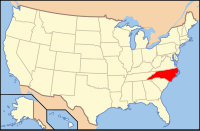Gates County, NC
| Gates County, North Carolina | ||
|---|---|---|

|
||
|
||
 Location in the U.S. state of North Carolina |
||
 North Carolina's location in the U.S. |
||
| Founded | 1779 | |
| Named for | General Horatio Gates | |
| Seat | Gatesville | |
| Largest town | Gatesville | |
| Area | ||
| • Total | 346 sq mi (896 km2) | |
| • Land | 340 sq mi (881 km2) | |
| • Water | 5.2 sq mi (13 km2), 1.5% | |
| Population | ||
| • (2010) | 12,197 | |
| • Density | 36/sq mi (14/km²) | |
| Congressional district | 1st | |
| Time zone | Eastern: UTC-5/-4 | |
| Website | Gates County, North Carolina | |
Gates County is a small, rural county located in the northeast portion of the U.S. state of North Carolina, on the border with Virginia. As of the 2010 census, the population was 12,197. Its county seat is Gatesville.
Gates County is included in the Virginia Beach-Norfolk-Newport News, VA-NC Metropolitan Statistical Area. It is part of the Albemarle Sound area of the Inner Banks.
As in other areas along the waterways, Native Americans had settled these lands for thousands of years, with different groups leaving and new ones migrating to settle again. They created settlements, increasingly permanent, along the Chowan River.
At the time of European contact, the Chowanoke was the largest tribe in North Carolina of the many in the Algonquian language family and occupied most of the territory along the river. After suffering dramatic population decreases by the early 17th century due to European infectious diseases, to which they had no immunity, most survivors were pushed out by encroaching Tuscarora, an Iroquoian-speaking tribe.
In 1585, the Ralph Lane Colony explored the Chowan River. They explored the river at least as far up as present-day Winton, North Carolina. In 1622, the John Pory Colony led an expedition from Virginia to the Chowan River. (Pory was secretary of the Province of Virginia.) In 1629, Sir Robert Heath was granted a patent to settle Carolina. This patent embraced Gates County.
...
Wikipedia

